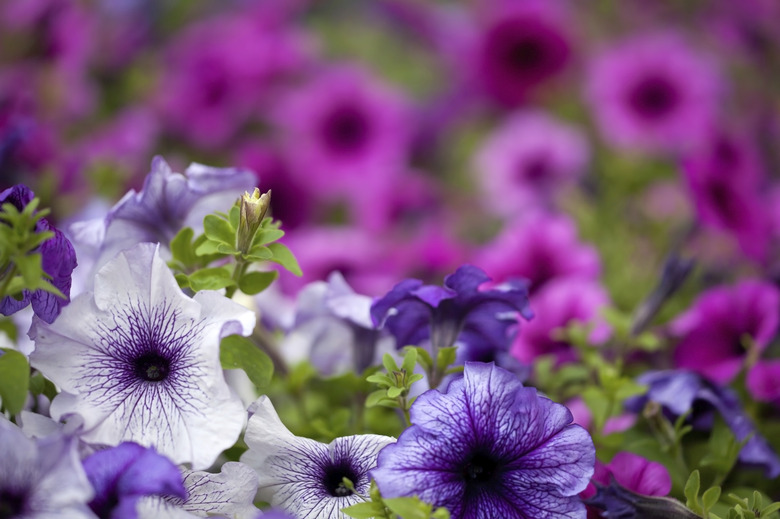How To Get Rid Of Worms On Petunias
We may receive a commission on purchases made from links.
With flowers as bountiful and bright as the sunny days they love, garden petunias (Petunia x hybrida) symbolize summer, but worms on petunias can be distressing and frustrating. Whether grown as perennials in U.S. Department of Agriculture plant hardiness zones 10 and 11 or as annuals elsewhere, they bloom for months at a stretch. When a petunia's flowers unfurl with hole-riddled petals, however, the plant is the victim of a tobacco budworm attack. Budworms are one of numerous petunia-infesting insect larvae. Each damages the plants differently, but organic measures are available for eliminating all three.
Green Worms: Tobacco Budworms
Green Worms: Tobacco Budworms
Tiny tobacco budworms hatch from eggs deposited on petunia leaves and buds by night-flying Helicoverpa (Heliothis) virescens moths. On petunias, their camouflaging coloration is light green. Budworms typically feed on the bases of the buds. Symptoms of an infestation include ragged petals, round holes at the bases of the flowers, infested buds failing to open and black specks of waste on the buds and leaves
Beating Tobacco Budworms
Beating Tobacco Budworms
Remove tobacco budworms from lightly infested petunias at dusk, when they emerge from their daytime hiding places around the base of the petunias to feed. Handpick them from the plants and drown them in soapy water.
If handpicking is too tedious, spray with ready-to-use, microbial Bacillus thuringiensis var. kurstaki (Btk) or spinosad pesticide. Worms that eat the pesticides stop feeding immediately, but may stay on the plants for several hours before dying. Bt doesn't harm bees, but spinosad is toxic to bees and should be used only according to label precautions to minimize its effects on pollinators. To protect honeybees, spray spinosad when the bees aren't likely to forage for at least three hours; late-evening, nighttime or early-morning spraying is best. Treat the petunias during calm, dry weather when no sun is hitting them.
Shake the bottle vigorously and coat the petunias until all their surfaces drip. Reapply after rain or at the pesticide brand's recommended interval, until the infestation subsides. Wear protective clothing, waterproof gloves, safety goggles and a respirator mask and follow the label's instructions when working with pesticides.
Spotted Worms: Variegated Cutworms
Spotted Worms: Variegated Cutworms
Named for the light yellow spots running down the tops of their bodies, variegated cutworms (Peridroma saucia) chew large, irregular holes in petunia leaves. They feed only at night or in very cloudy weather. During daylight, the cutworms hide in the mulch or soil around the base of the petunias, where their brownish-black color is difficult to spot.
Controlling Variegated Cutworms
Controlling Variegated Cutworms
After dark, search the petunias by flashlight and pluck the cutworms from the plants. During the day, use a garden trowel to scrape a trench in the soil 2 or 3 inches from the stems. The worms curl into a C-position when uncovered. Drown them in soapy water. For hands-off cutworm control, spray the petunias with Btk as you would to eliminate budworms.
Yellow Serpentine Leafminer Worms
Yellow Serpentine Leafminer Worms
Yellow serpentine leafminer worms (Lyromiza trifolii) are the larvae of tiny, yellow and black flies. The chances of ever seeing one, however, are miniscule. The female flies insert their eggs into petunia leaf tissue, where the worms create winding, whitish tunnels as they eat their way toward pupation. You can see evidence of their presence by the squiggly lines of their tunnels that appear on the leaves. Leafminers rarely do more than cosmetic damage, but a heavily infested petunia may experience slowed growth or loss of its affected leaves.
Eliminating Leafminer Worms
Eliminating Leafminer Worms
Chemical pesticides have little effect on leaf-protected leafminers. To control them, pick off and dispose of infested leaves at the first sign of the worm's trails. Plant annual dill (Anethum graveolens) or perennial yarrow (Achilleum millefolium), hardy in USDA zones 4 through 9, near your petunias. They attract predatory wasps that feed on leafminers. Control the leafminers with spinosad, applied as you would to manage budworms.
References
- Missouri Botanical Garden: Petunia (Group)
- UC Statewide IPM: Petunia—Petunia x Hybrida
- University of Florida IFAS: Featured Creatures: Tobacco Budworm
- Missour Botanical Garden: Caterpillars — Surface Feeders
- North Dakota State University Extension: Variegated Cutworm
- University of Washington Botanic Gardens: Elizabeth C. Miller Library: Gardening Answers Knowledge Base
- UC Statewide IPM Online: Leafminers—Liriomyza Spp.
- Missouri Botanical Garden: Anethum graveolens
